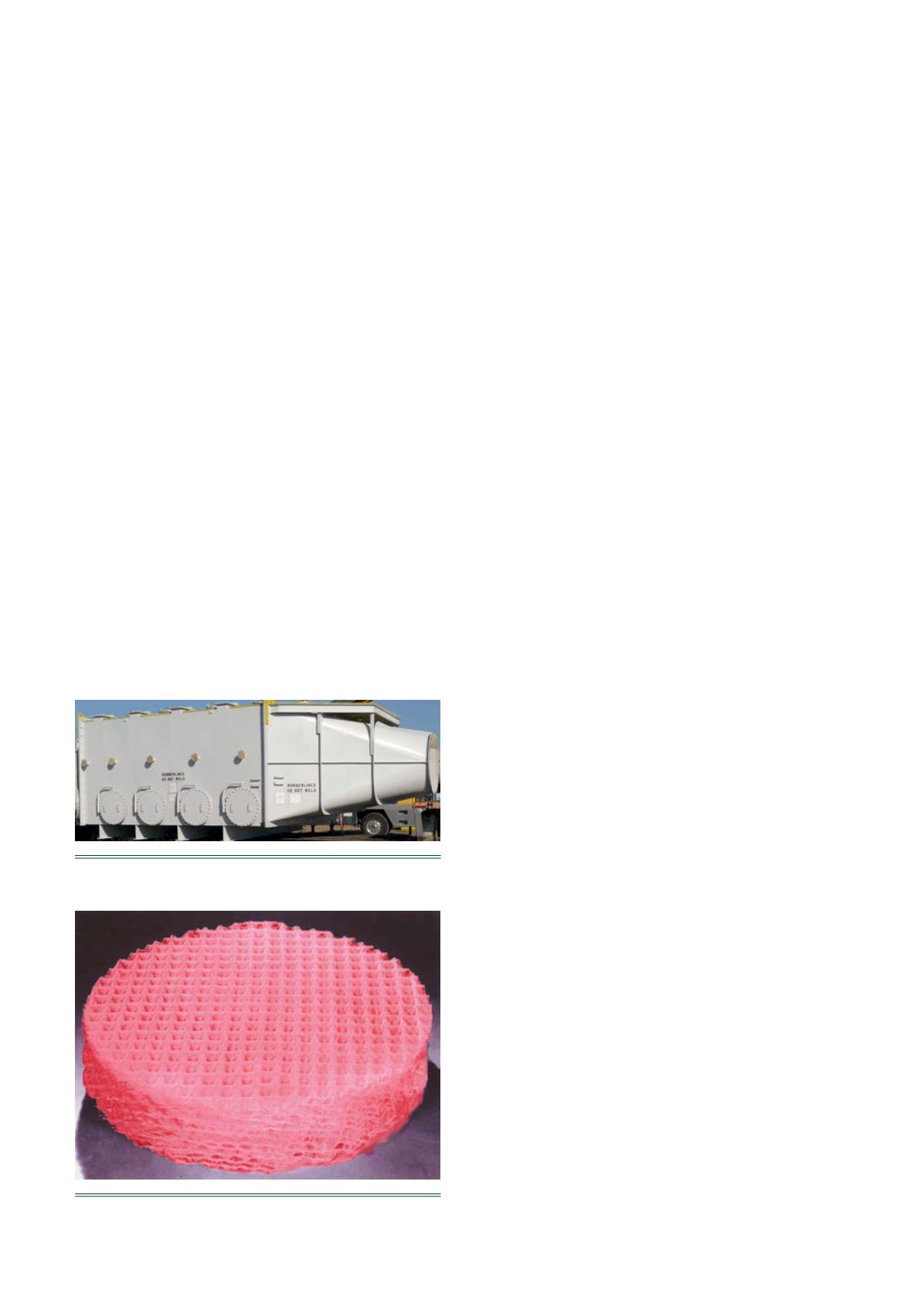
90
| WORLD FERTILIZER |
NOVEMBER 2016
a packing media for prevention of air pollution in the
fertilizer industry.
Gas cleaning
The primary purposes of gas cleaning are the recovery of
raw materials and byproducts, while meeting present and
future pollution emission standards set by the local, state
and federal governments and/or other regulatory agencies
and minimising ozone depletion by reducing fluorine, SO
X
,
NO
X
, levels in the air.
The phosphate fertilizer industry covers different
chemical processes in order to manufacture different
products. This generates off-gases and particulate matter
from various steps during the process, including reaction,
filtration, clarification, evaporation, granulation, drying,
cooling and screening, product storage and handling, and
crushing, grinding and reclaiming.
Different types of gas cleaning (dry and/or wet) are
adopted depending upon the types and size of particles or
gaseous components present in vent air. Also, handling
characteristics, electrical properties, wettability, toxicity
and flammability are taken into account for design and
operation purposes.
Dust collectors, such as cyclones, are used to recover
large size particles in gaseous effluents greater than 10
µ
m,
whereas fabric filters (bag-house) and electrostatic
precipitators can be considered to remove small size
particles less than 10
µ
m size from dust laden air in the
process. In addition, different types of wet scrubbers are
used for the final cleanup of particles and pollutants from
the process vent gases before it is emitted to the
atmosphere.
Wet scrubbers
There are approximately four different types of wet gas
scrubbers that are common in the fertilizer industry, where
gaseous pollutants and particulate matter are scrubbed
either with a recycle solution or contaminated pond water
of varying compositions. They are broadly classified as
low-, medium- and high-energy scrubbers.
n
Spray (simple, cyclonic and water impact).
n
Packed tower.
n
Venturi (cyclonic and coaxial).
n
Cross/semi-cross flow.
In general, low-energy scrubbers with 3 – 6 in. water
gauge of pressure drop P include spray (simple, cyclonic
or water impact) towers, whereas packed bed and cross or
semi-cross flow scrubbers are categorised as
medium-energy units with 6 – 9 in. water gauge P. Venturi
types, either cyclonic or coaxcial scrubbers, are classified
as high-energy scrubbers that generally operate between
9 – 12 in. water gauge P.
Spray scrubber
These units are suitable for handling large gas volumes
with high dust content. Pressure drops fall within a
3 – 6 in. water gauge range, which includes a mist
eliminator to control entrainment problems. These have
been developed to handle large particles of 5 – 10
µ
m size
or more by the absorption of soluble gases, including NH
3
,
SO
2
, SiF
4
, HF, as well as dust or particulate matter.
Spray scrubbers are used in the absorption of NH
3
,
NO
X
, fluorides, urea, dust, SO
2
, using a weak acid or alkali
solution with an absorption efficiency around 94 – 95%.
However, to date these types are only used in the industry
combined with a secondary scrubber in order to improve
desired efficiency.
Packed tower
This type of scrubber is most suitable for gas absorption,
rather than dust or particle collection, using mass transfer
between a liquid and a gas stream flowing counter current
through a specific packing material. Packed towers are
commonly used in the fertilizer industry due to the high
efficiency at increased ‘ P’ in order to meet the present
environmental pollution standards. The absorption
efficiency may drop due to the quality of the scrubbing
liquid and the type of packing material selected because
of solid ‘build-up’.
Venturi scrubber
Both venturi cyclonic and coaxial types have been in use in
phosphoric acid and DAP, MAP and GTSP plants for
handling dirty gas loaded with dust and particulate matter
at a pressure drop varying between 6 – 12 in. water gauge
P. An additional pressure drop of 5 in. water gauge is
required to reduce dust concentration from
0.06 to 0.03 g/ft
3
(equivalent to 135 mg to 65 mg/Nm
3
)
depending on particle size of the specific dust, fume or
mist to be removed and absorption efficiency of SO
X
,
NO
X
, NH
3
desired. The mechanism of particle collection in
the venturi scrubber is known to be by inertial impaction
Figure 1.
Phosphoric acid fume scrubber.
Figure 2.
B-GON mist eliminator in ETFE.


